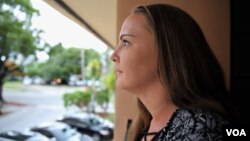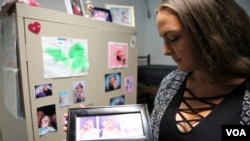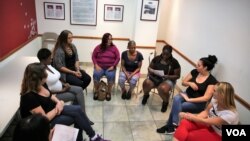Before it became the worst day of her life, Allison Norland spread a blanket on the grass outside her father-in–law's house so her infant daughter could crawl on the soft ground. New to motherhood, her first child was a surprise. "I found out when I was six and a half months pregnant, which was unbelievable for me," she said. "Then I went to the hospital, found out I was in labor, obviously still using."
The daughter of an alcoholic, Allison says she has a highly addictive personality. Her drug use started with marijuana when she was 18. "I would start kind of hanging out with my sister and the older crowd and drink, and then the coke [cocaine] started. I was actually dating a man at the time who was selling weed and cocaine. So, easy access I guess," she told us.
At 19, she met the man she would eventually marry. He introduced her to Oxycodone, a commonly prescribed, but highly addictive, semi-synthetic opioid.
"We started using when we would go out of town to visit his friends and then it kind of proceeded to [finding] some people down where we live who were selling [Oxycodone] and it kind of became more common place," she said.
After two back-to-back car accidents while driving high, she was sent to a pain doctor for her injuries. "It was straight to 30 milligrams of Oxycodone. I was getting 90 pills a month. That doctor shut down and I went to another doctor and proceeded to 150 pills a month," she said. "I was using every day."
Pain medication
She says the doctors never asked her if she had a history of illegal drug use or had ever abused opioids. Estimates are six out of 10 heroin users on the street started out with pain medication prescribed by a doctor. As the opioid crisis has exploded across the country, the medical community has come under scrutiny for the way they treat pain, and addiction specialists often point a finger directly at the conduct of the medical community.
Allison developed what she described as an intense addiction. The birth of her daughter was her wake-up call. Her obvious drug use was called to the attention of child protective services in Miami-Dade County where she lived. She says they almost took her newborn from her.
"I was so guilty and so ashamed that I had let that go on as long as I did. But I had her, she was healthy, no withdrawal symptoms, no anything," she said.
She stayed clean for seven months. Then tragedy struck. As Allison watched her daughter play on the blanket that day in the back yard, her father-in-law accidentally drove his car off the driveway, striking and killing the little girl.
After seeing her daughter in the hospital for the last time, Allison drove straight to where she knew she could get pills. She says she used every day for the next year.
"Every day I pushed the limit further and further because I didn't know how to be anymore, and what to be anymore. To go from being a mom and loving this thing so much, so much more than I love myself, to having her gone and this absence in my heart, it was really hard," she said.
The incident left Allison with Post-Traumatic Stress Syndrome, and depression. The years passed in a fog. After an arrest, and time at another rehabilitation facility, Allison was ordered by the court to go to The Village, in Miami Florida, one of several residential and outpatient rehab centers run by Westcare, a non-profit healthcare corporation that specializes in addiction services.
Treating addiction
At first, she was hostile toward being at The Village, a renovated old Florida motel-style complex a few blocks from Biscayne Bay in the Edgewater neighborhood north of downtown Miami. Now 28, Allison sat with us in the room she shares with two other women, the walls lined with metal bunk beds and cabinets decorated with family pictures.
"I snuck in phones [which are forbidden]. I would get caught smoking on the facility, but then again I fought a lot. I fought in here, I fought out there. I just fought. I was so angry and broken down that I couldn't be that person anymore," she said.
Allison was initially ordered to stay at the facility for 90 days. She has chosen to stay longer. Now in her fourth month, she has slowly begun to unravel the threads of her addiction. The problems were not socio-economic. "I didn't grow up on the streets," she told us. "My family was upper middle-class."
For decades, opioid abuse predominantly affected people of color in poverty-wracked inner cities. Today's crisis has moved into the white middle-class suburbs and spread to small towns across the country.
When we asked her what an addict loses, she said "everything." At the core of her loss were the morals and values she grew up with.
"To learn to look people in the eye and tell the truth because that is a big part of addiction – lying. I have to learn how to look people in the eye. I have to learn how to stand up straight. I have to learn how to love myself. That is what I lost most of all," she said.
The Village uses a combination of medication, and individual and group therapy to treat its clients.
Patients are given Suboxone, a synthetic opioid strip that dissolves under the tongue. There has been some controversy with treating opioid addiction with opioids, but The Village says it has used Suboxone with great success. Delivered in small doses, the strips can eliminate withdrawal symptoms in 15 minutes. Suboxone also eliminates the cravings for opioids with limited side effects. Clients continue on the drug for months.
"With medication, we can begin to have an effect on your cravings for drugs and keep you engaged in your recovery," says Frank Rabbito, senior vice president for Westcare, which runs The Village. "Medication keeps you away from illegal drugs and gives you an opportunity to engage in your recovery, be monitored by us for a period of time, and move toward a greater independent lifestyle."
Therapy sessions
Allison credits the relationship and trust she has built with her therapist for her turnaround. Like many substance abusers, she has a history of physical, mental and sexual abuse going back to her childhood.
"I would say 80 percent of substance users have trauma in their past," said Alexandra Kirkland, a therapist who works with patients at The Village. "And it causes them to have depressive symptoms. So when they flash back and think about the trauma, it breaks into their daily functioning, and many times they use substances as an escape to deal with the trauma."
"My therapist has been incredible and has helped me through things I have done in the dark that I never thought would come to light," Allison told us. "There are things that happened to me that I never wanted to talk about I have talked about with her. And it is because I know she can understand."
The sessions have helped her confront some painful realities, such as using drugs while pregnant.
"I put my daughter in harm's way for a pill. I put my life in danger for a pill. I was risking everything for this drug. And that is it – chasing a high that was never going to be enough, "she said.
It's hard to reconcile the darkness she describes with the person in front of us; she now carries herself with an air of happiness and confidence, and can flash a smile that lights up the room. Allison wants to stay even longer at the The Village and further her recovery.
The odds are against her. Researchers estimate a mere three percent of addicts stay clean for life. Allison is not deterred. She now wants to become an addiction specialist.
"That is my goal," she says, brimming with energy. "It is exciting to work toward something. That is a huge thing. I want to help people. People like me."











